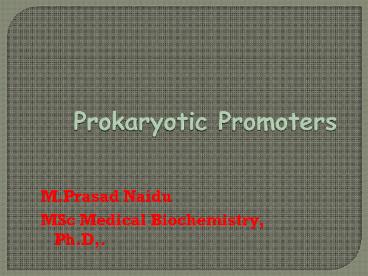Promoter_Characterization - PowerPoint PPT Presentation
Title:
Promoter_Characterization
Description:
BIOCHEMISTRY – PowerPoint PPT presentation
Number of Views:26
Title: Promoter_Characterization
1
Prokaryotic Promoters
M.Prasad Naidu MSc Medical Biochemistry, Ph.D,.
2
Prokaryotic Genes
- Recall - prokaryotes have a single circular
chromosome - Also, no cell nucleus, and no introns
- Therefore, prokaryotic gene structure is quite
simple
Translational start site (AUG)
Translational stop site
Promoter region
Open Reading Frame
Transcriptional start site
Operator sequence
Transcriptional stop site
3
Prokaryotic Operons
Operon structure
Downstream
Upstream
Promoter
Gene 1
Gene 2
Gene 3
In prokaryotes, sometimes genes that are part of
the same operational pathway are grouped together
under a single promoter. They then produce a
pre-mRNA.
4
Bacterial Gene Signals
1
Gene 2
Gene 1
Bacterial genomes have simple gene structure
- - Promoter
- -35 sequence (T82T84G78A65C54A45) 15-20 bp
- -10 sequence (T80A95T45A60A50T96) 5-9 bp
(Pribnow Box) - Start of transcription 1 initiation start
Purine90 - Translation binding site (Shine-Dalgarno) 10 bp
upstream of - AUG (AGGAGG)
- - One or more Open Reading Frame
- Start-codon ATG (unless sequence is partial)
- stop codon for gene 1 ..
- Separated by intercistronic sequences.
5
Promoters
- Promoter sequences facilitate the binding of the
RNA polymerase to the DNA to be transcribed. - Promoters of different genes have distinct
sequences, although most have characteristic
short sequences of 6 to 10 bases at a
position between 10 to 30 nucleotides upstream
- -10 sequence Hexamer TATAAT Pribnow Box
(Pribnow, 1975) and -35 sequence, an hexamer
TTGACA in prokaryotes.
6
Prokaryotic promoter
7
Typical E. coli Promoters
TATAAT
Pribnow Box
8
Consensus sequences of E. coli Promoters
T80A95T45A60A50T96
- the sequence at the promoter can regulate
efficiency of initiation - different sigma factors may associate with RNA
polymerase, which target specific promoters
9
Methods for characterization of promoters
- DNAse protection method
- DMS protection method
- Foot-printing method
10
1. DNase Protection method
- The region of DNA in contact with RNA polymerase
can be isolated - Allow the piece of DNA containing the promoter to
interact with RNA polymerase - Treat with DNase I
- Dissociate the enzyme and isolate the DNA
- Determine the size by gel electrophoresis
- Determine the sequence by standard method
11
_ _ _ _ _ _
_ _ _ _ _ _
DNase I
Mono and dinucleotides
DNA molecule with promoter
RNAP DNA complex
RNAP
Dissociate DNA from enzyme
Sequence the Promoter DNA
Promoter region
12
2. DMS Protection method
- Specific points of contact within the contact
region can be identified - Dimethyl sulphate methylates N3 of A or N7 of G,
but not C or T - Glycosidic bond of methylated As or Gs is
unstable and can be broken by heating at neutral
pH leaving deoxy ribose from the chain DNA
degradation results - Region of the DNA bound by RNA polymerase will
not be methylated it will be intact - Dissociate the enzyme and isolate the DNA
fragment that corresponds to the promoter
13
DNA molecule with promoter
RNAP
DMS
_ _ _ _ _ _
_ _ _ _ _ _
Mono and dinucleotides
RNAP DNA complex
Methylated purines
Dissociate DNA from enzyme
Sequence the Promoter DNA
Promoter region
14
3. Foot-printing method
- Take a DNA fragment with known Restriction sites
- Dephosphorylation Alkaline phosphatase
- End labelling 5 is to be labelled with
- gamma-32P- ATP using T4 polynucleotide
kinase - Remove a small fragment by RE digestion
- Allow the labelled DNA to interact with RNA
polymerase - - One sample is to be maintained without
RNAP - treatment
- Using DNA endonuclease briefly digest the DNA
sample treated with RNAP Nicking occurs
randomly at all places except those protected by
RNAP - Analyze both the samples (with and without RNAP
interaction) following agarose gel electrophoresis
A method to detect where a protein binds to DNA
15
(No Transcript)
16
(No Transcript)
17
Foot-printing
One end labelled DNA
RNAP
Used extensively for mapping contact points
between promoter sequences and RNA polymerase
and/or regulatory proteins
No RNAP
18
Interpretation
- If the DNA contains n bp and RNAP is not added,
n sizes of DNA fragments will be present - However, if RNAP binds to x bp and thereby
prevents access of the DNA to the nuclease, only
nx different sizes of DNA fragments will be
represented - The positions of the missing bands are the
positions of the n bands on DNA
19
THANK YOU































